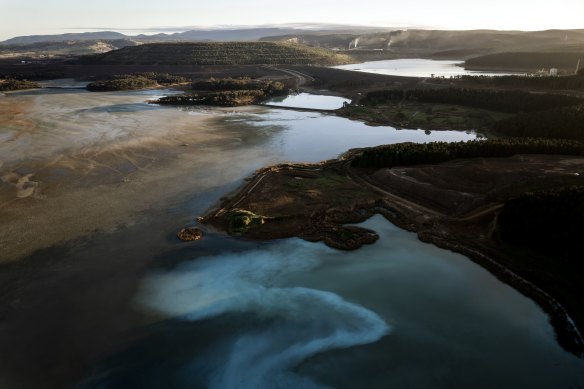Water tank testing reveals heavy metal levels in residents’ drinking supply
By Laura Chung
Water samples from the properties surrounding one of Australia’s largest gold mines have failed to show the presence of widespread heavy metals, an investigation by the NSW environmental watchdog has revealed.
The NSW Environment Protection Authority (EPA) completed water testing for more than 85 properties in the Cadia Valley following concerns from residents that pollution from the mine was affecting their health.

Part of the Cadia Hill Gold Mine tailings dam at first light.Credit: Brook Mitchell
EPA officers collected and tested water samples from household kitchen taps and water tanks and compared them to the Australian Drinking Water Guidelines. Most results from kitchen tap samples showed metal concentrations below the guideline values.
At two properties, lead was detected at or marginally above the accepted level of lead from samples taken in the kitchen tap, but water tank samples from the same properties were below guideline values.
Water tank samples showed six properties had levels of lead above the guideline’s values, while kitchen tap samples at these properties were below guideline values.
Once all tests from the water sampling program are completed, comparisons will be made with water sampling results previously undertaken by NSW Health, industry and the community. The EPA’s and NSW Health’s expert panels will consider the results.
Earlier this year, residents self-tested their tank water and found that, of the 68 samples, 15 were 10 times the safe lead level recommended by the Australian drinking water guidelines. As yet, there is no proven link between the mine and these complaints.
The EPA’s results come just days after a parliamentary inquiry was announced that will investigate the current and future impacts of gold, silver, lead and zinc mining on human health, as well as the effects on land, water and air quality. The inquiry will also examine regulatory framework, rehabilitation and decommissioning practices.
The EPA has also begun a separate extensive air monitoring program in the Cadia Valley.
In an update to investors earlier on Tuesday, Cadia’s owners, Newcrest, said a 12-month study conducted by the federal government’s Australian Nuclear Science Technology Organisation had found Cadia was meeting air quality standards for the mine’s surrounding region, and had highlighted that metals including lead, nickel, selenium and chromium did not exceed national standards, occurring at “very low levels”.
A guide to the environment, what’s happening to it, what’s being done about it and what it means for the future. Sign up to our fortnightly Clear Air newsletter here.